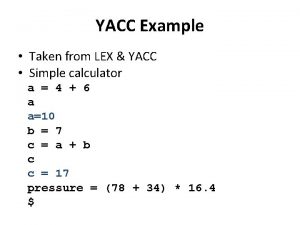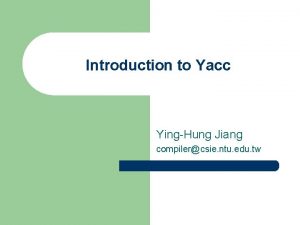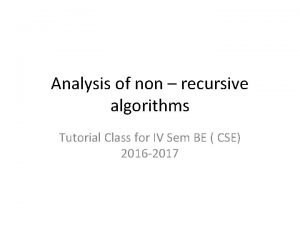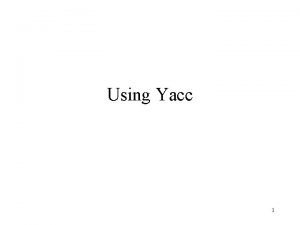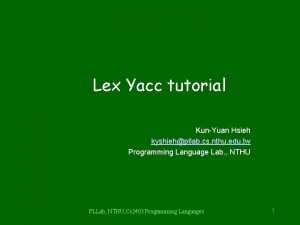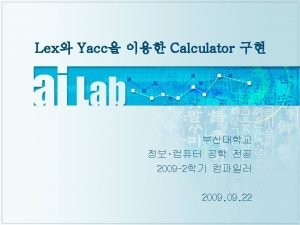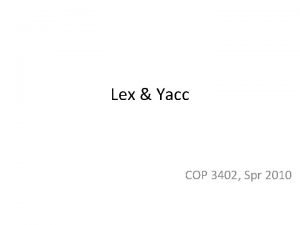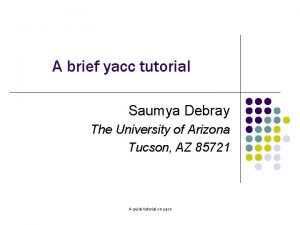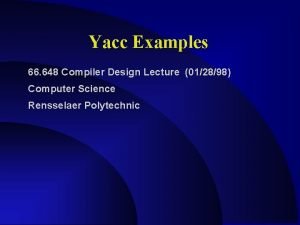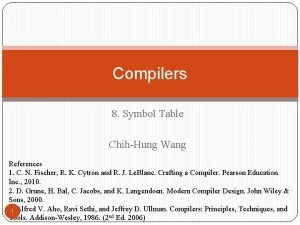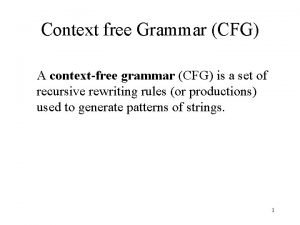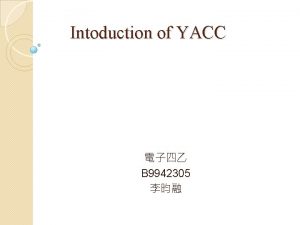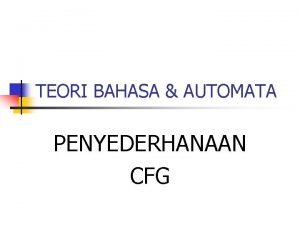Using Yacc 1 Introduction Grammar CFG Recursive Rules













- Slides: 13

Using Yacc 1

Introduction • Grammar – CFG – Recursive Rules • Shift/Reduce Parsing – See Figure 3 -2. – LALR(1) – What Yacc Cannot Parse • It cannot deal with ambiguous grammars • If you give it one that it cannot handle it will tell you, so there is no problem of overcomplex parsers silently failing. 2

The Structure of a Yacc grammar (Definition section) %% (Rules section) %% (User subroutines section) 3

The Definition Section • The definition section includes declarations of the tokens used in the grammar, the types of values used on the parser stack, and other odds and ends. – You don’t have to specify the number of the token. • It can also include a literal block, C code enclosed in %{ %} 4

The Rules Section • Since ASCII keyboards don’t have a key, we use a colon between the left- and right-hand sides of a rule, and we put a semicolon at the end of each rule • The symbol on the left-hand side of the first rule in the grammar is normally the start symbol, though you can use a %start declaration in the definition section to override that. 5

Symbol Values and Actions • Every symbol in a yacc parser has a value – The semantic record – A number, a literal text string, …. – Nonterminal symbols can have any values you want, created by code in the parser – In real parsers, the values of different symbols use different data types • int, double, char *, …. • If you have multiple value types, you have to list all the value types used in a parser so that yacc can create a C union typedef called YYSTYPE to contain them • By default, yacc makes all values of type int 6

Symbol Values and Actions • $$: – The value of the LHS symbol – The semantic routine should give value to it. • $i: – The value of the i-th symbol in the RHS of the production • Terminal symbol: The value was given by the lex. • Nonterminal symbol: The value was given previously by an execution of some semantic routine. 7

The Lexer • The parser is the higher level routine, and calls the lexer yylex() • Yacc defines the token names in the parser as C preprocessor names in y. tab. h – See ch 3 -01. l – Whenever the lexer returns a token to the parser, if the token has an associated value, the lexer must store the value in yylval before returning • In the first example, we explicitly declare yylval. • In more complex parsers, yacc defines yylval as a union and puts the definition in y. tab. h 8

Compiling and Running a Simple Parser • See P. 59. • Note that you cannot exchange the order of the executions of yacc and lex. 9

Arithmetic Expressions and Ambiguity • You may input an ambiguity grammar to test Yacc – There are 16 shift/reduce conflicts in the program of P. 60 • There are two ways to specify precedence and associativity in a grammar implicitly and explicitly – To specify them implicitly, • Rewrite the grammar using separate non-terminal symbols for each precedence level – See P. 62 – To specify them explicitly • Add some rule to the definition section %left ‘+’ ‘-’ %left ‘*’ ‘/’ %nonassoc UMINUS 10

Exercise • Using the expression rules shown in P. 62 of “lex and yacc” to write a yacc program. – Hint: ch 3 -01. y and ch 3 -01. l • Please list your source code and execution results. 11

When Not to Use Precedence Rules • You can use precedence rules to fix any shift/reduce conflict that occurs in the grammar • We recommend that you use precedence in only two situations – In expression grammars – To resolve the “dangling else” conflict in grammars for if-then-else language constructs 12

Variables and Typed Tokens • See Example 3 -2, P. 64 • Symbol Values and %union 13
